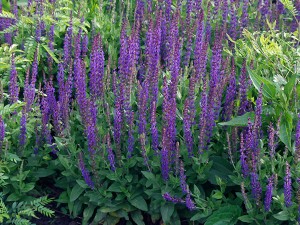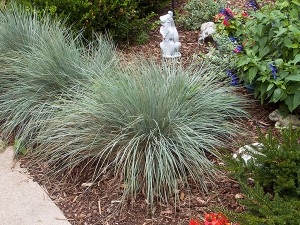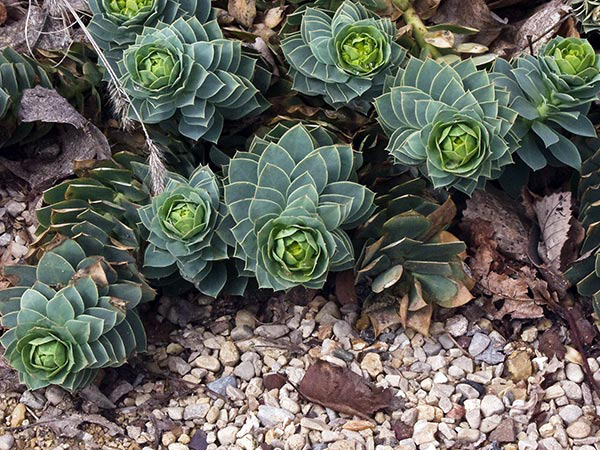Submitted by Mary Jo Buza
A Hot Design for Skinny Places

Every gardener I know has at least one spot he or she considers to be a problem. As a landscape designer, I visit dozens of gardens a year. The greatest challenge for home gardeners is the narrow side yard that faces south or west.
The side yard is typically dominated by two strong vertical structures: the wall of the house and a six foot tall wooden fence. The side yard is usually narrow – less than twelve feet wide and there are also heat pumps and other utilities to screen. In addition, it connects the garage to the backyard, and it receives moderate to heavy foot traffic.
The Design Challenge
The first design challenge is to break up the walls. There are lots of options. A trellis is a good place to start. For a long narrow space I generally recommend 2 or 3 trellises evenly spaced over the length of the wall. Because the wall faces south or west, I would install a wood trellis and avoid a wrought iron trellis. Wrought iron simply absorbs too much heat and gets too hot. Plants will not grow on it. If you like wrought iron, consider wrought iron for wall art, such as panels or decorative plaques, which also add interest and effectively break up the walls. A wall fountain also fits nicely into narrow spaces and brings the additional benefit of the soothing sound of water.
The second design challenge is the path. In a narrow space I favor the use of flagstone stepping stones. For me the irregular shape of the flagstone softens the hard straight lines created by the fence and the wall. If you prefer the use of cement pavers, consider a basket weave pattern broken by a diamond pattern at regular intervals. The use of the two patterns for the pavers breaks up the long narrow space and provides interest.
The third design challenge is to screen utilities, for example, a heat pump. I suggest installing a lattice fence with a gate to retain access for maintenance. The side yard is usually too narrow to use plants as a screen for heat pumps
The fourth design challenge is to select plants for a narrow space, that will not overcrowd it, and that will thrive in the heat generated from a south or west wall. In this setting, I limit the color palette and plant varieties. Doing this you’ll have enough room to plant several plants of each variety. In garden design, less is more. You can get a bigger impact in a garden by repeating a few plants, rather than fill an area with lots of different plants.
Here is a list of companion plants:
Juniper ‘Skyrocket’: I will admit I am not a fan of junipers, but I do like skyrocket. It is the perfect plant for a hot and narrow space. It grows only 2-3 feet wide and it has a fantastic blue color! Skyrocket is a good alternative to a trellis.

Blue oat grass is a true evergreen ornamental grass. It maintains the powder blue color all winter. It is a great companion for skyrocket juniper because of the contrast in textures. Blue oat grass grows only 2 to 3 feet tall and wide.
To add flowers plants consider lavender, rosemary ‘Arp’, or perennial salvia such as ‘Blue Queen’, or ‘Caradonna’. These perennials all can take the heat and have blue flowers which will complement the skyrocket juniper and the blue oat grass. I would select one of these three perennials and plant them in groups of three for maximum impact.
To finish the plant scheme consider adding a helianthemum or a euphorbia ‘Donkey Tail’. Helianthemum is a plant all gardens should have! It is a compact evergreen perennial that grows 6 inches tall. It blooms profusely in late May, and is available in a variety of colors: pink, yellow, maroon, white, and orange. I would select either the pink or orange flowers. If you prefer the unusual or consider yourself to be eclectic you will love the euphorbia ‘Donkey Tail’. The succulent leaves are blue-green, spaced very closely on the stems. The leaves appear to spiral around the stem. It is short and grows 8 to12 inch ‘tails’. It displays showy yellow bracts in spring. Plant either the helianthemum or the euphorbia near front of the border next to the path.
Author Mary Jo Buza, is a landscape designer. She has over 20 years experience designing, and teaching gardening in the South Sound region. For more information on a custom landscape design or consultation call her at 923-1733 or visit her website: www.gardendesignsbymaryjobuza.com
















































